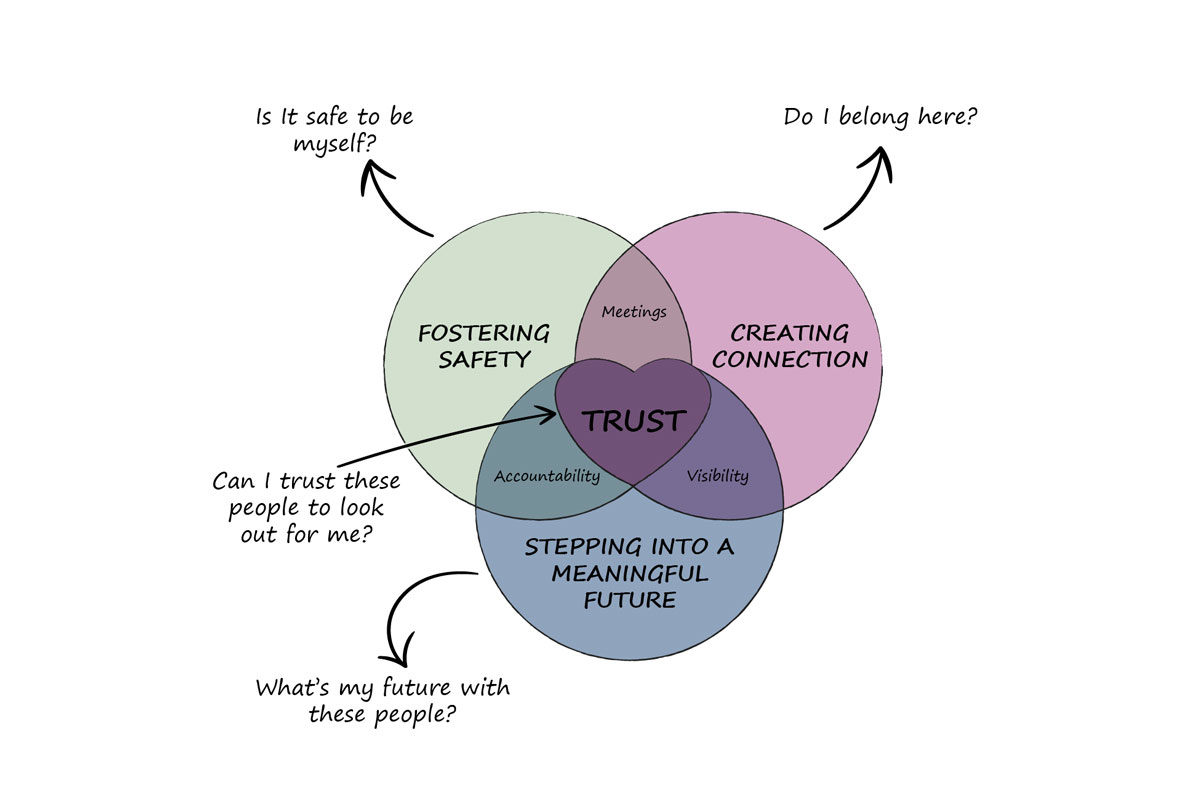Every leader wants an energetic team that sits in the achievement zone: innovating, being accountable, achieving goals and solving complex problems. It feels great – to both the leader and their direct reports.
Yet we live in an uncertain world where teams are no longer working in the same location, but scattered. Employees feel uninspired or anxious about what will happen next. They are disconnected, disengaged and depleted. Turnover and burnout are escalating. Leaders can no longer rely on face-to-face gatherings to boost morale.
But constant change and hybrid work environments aren’t the issue. They are here to stay. The problem is that leaders are still leading using outdated leadership skills that were created when we worked in a stable environment. A time when technical skills mattered. Now is the time to lead differently.
And the secret sauce is trust.
As human beings we all want to be trusted. Our deepest need is to be visible, to feel heard and that we belong. We want people to trust us to do a good job, to value what we do and involve us in their future plans.
It doesn’t matter where you work or how you work. If you have trust as the foundation for your team environment you can put your team anywhere and under enormous pressure and they will thrive. Adapting to uncontrollable situations, making fast decisions, continually improving and finding new market opportunities. So how do you create a trusting team culture?
Let’s peek inside our brain first.
How the brain works
Deep inside our brain is our limbic brain. It’s not a thinking brain, but a survival one. It is responsible for our feelings such as trust and loyalty, decision-making and handling stress. But the real kicker is it has no capacity for language.
That’s why it’s hard to explain why we trust someone. We process whether we can trust someone through our emotions. We don’t trust others by what they say, it’s how they make us feel. It’s their consistent actions that show that they care about our well-being that determine whether we feel we can or cannot trust them.
That’s why you can’t talk your way into trust; you have to behave your way into it. Our brains are regularly scanning the environment subconsciously asking “Is it safe to be myself?”, “Do I belong here?” and “What’s my future with these people?”
Today it’s more important than ever that leaders know how to communicate both verbally and non-verbally to the part of the brain that manages trust. The limbic brain that doesn’t understand language, but feelings. Our brains are designed to need lots of signalling. This requires learning techniques that signal to people that “together we can do this.”
Introducing the integrated trust building system

The Integrated Trust Building System helps leaders to focus on the three most important practices to emotionally engage employees that pull people into the achievement zone.
These are:
- Fostering Safety –This requires creating a physically and psychologically safe environment where people can take risks and speak up. It involves reducing interpersonal risk, increasing support and fostering a learning environment.
- Creating connection – People need to feel a sense of connection with their team to increase their ability to succeed in their role. This involves breaking down the meaning of work to employees through linking their personal impact, conveying how their work helps others, and the broader context of how all the moving parts work together in a company.
- Stepping into a Meaningful Future – When people don’t know what’s going to happen next and the situation feels unsafe they will push back from committing to goals. The way to avoid this is to involve people in a meaningful future through clearing articulating the company vision and people’s career pathway.
The trick here is to always touch on these three factors in your dealings with others. This helps people breathe more easily knowing they are supported and valued – making it much easier to face difficult challenges.
Working the system
There are three corresponding interactions where you communicate these three practices.
These are:
- Meetings/one-on-ones – Trust is enabled through communication. Regular team meetings and dedicated time with your direct reports encourages transparent and honest two-way dialogue.
- Visibility – People believe what they can see. And it’s much more than being transparent. It includes visibility of information, priorities and progress both within and across teams, and in leadership behaviours. Even employees must visibly demonstrate that they are working.
- Accountability – In a workplace, trust is inextricably linked to performance and capabilities. Accountability is two-way. It’s about demanding accountability and being accountable.
The good news is that these three practices don’t take much time to deliver, it just takes practice and courage. And when you get them right, they provide a powerful shortcut to navigating the complexity of human behaviours and beliefs.
Today, leaders need to reassure people that their emotional needs are being met through signalling that the organisation centres around people, not profit. And that they care about their direct reports – their career pathway, mental health and job satisfaction.
Ask yourself weekly:
- What can I do to increase safety in my team?
- How can I ensure people feel connected to one another?
- How can I best communicate the future for each individual in my team?
The key is to start with small steps that you keep building upon. Try new things and experiment. Understand that there is no finish line – trust is a process, not a single event – and that these behaviours need to become part of who you are, not what you do when others are watching.
Marie-Claire Ross is a speaker, trainer and coach at Trustologie who helps leaders and organisations improve trust in teams. She is also the author of the new book Trusted To Thrive: How Leaders Create Connected and Accountable Teams.
Read next: Real power means knowing what people value and how to access it







